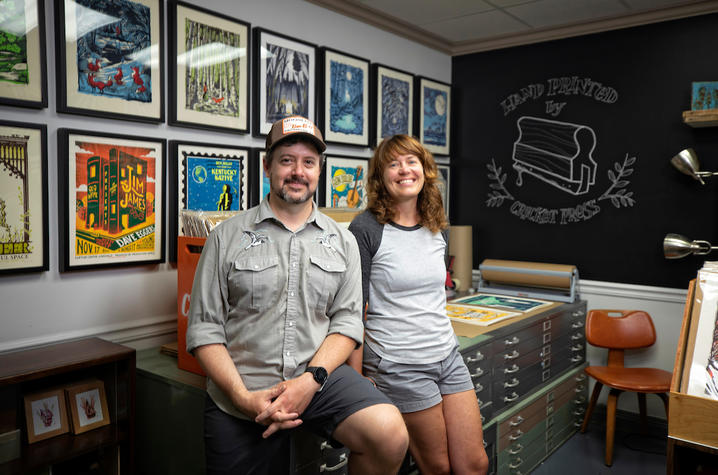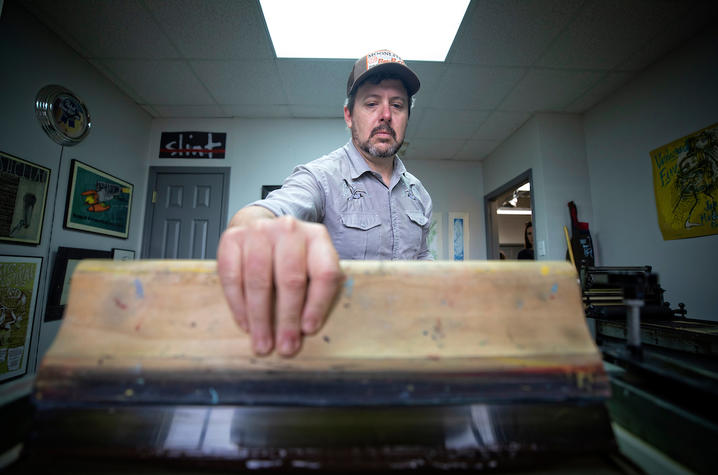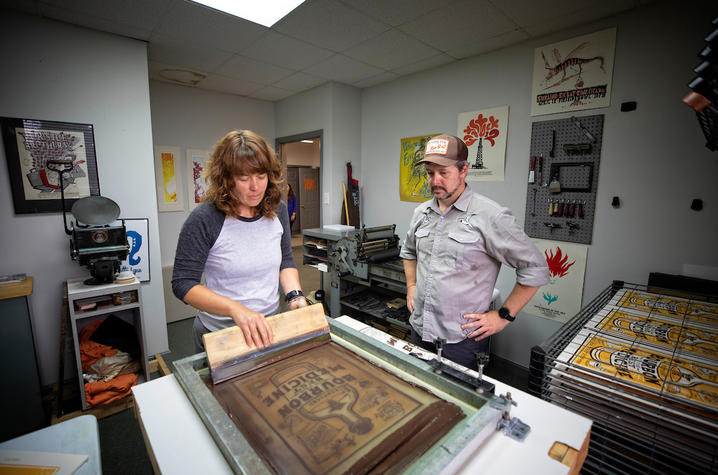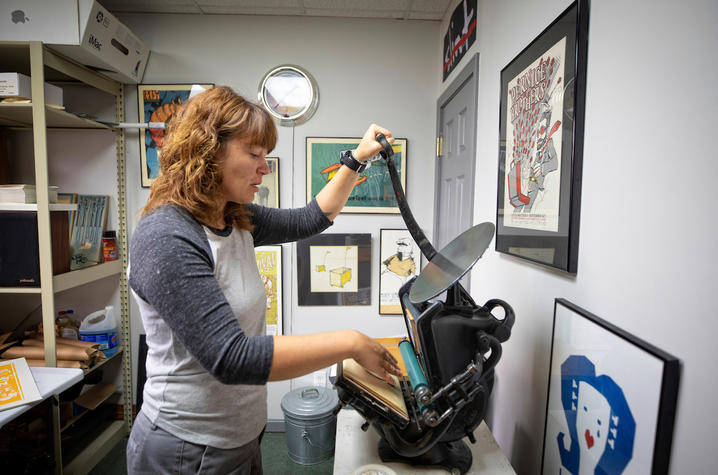Cricket Press' Picture Perfect Partnership From UK to Today
LEXINGTON, Ky. (Aug. 14, 2019) — It was a chance meeting carpooling on a University of Kentucky class trip to a photography lecture that brought together two of Lexington's most noted young artists.
Art studio alumni Brian Turner, a native of Frankfort, Kentucky, and Sara Turner, of Lexington, took different paths to UK, but it was a passion for photography that sparked not only a relationship, but the founding of one of the region's first and most successful silk-screen presses — Cricket Press.
Sixteen years later, Cricket Press is nationally known for their designing and hand printing of silk-screened posters for concerts. They have created posters for such noted musical acts as My Morning Jacket, The Decemberists, Sugarland, Jeff Tweedy and Ben Sollee, just to name a few. Most recently, music lovers saw their work on the Railbird Festival poster.
In addition to concert, event and art posters, the printmakers are the creative talent behind some of the Bluegrass' most iconic illustrations, logos and T-shirt designs, working with such popular local businesses and organizations as West Sixth Brewing Company, Kentucky for Kentucky and various colleges and departments at UK.
Art lovers across the country can check out this talented duo's work on Etsy. And, Central Kentucky fans of their work can catch up with Cricket Press this weekend at their booth at Woodland Art Fair running Aug. 17-18, at Lexington's Woodland Park.
UKNow recently sat down with the Turners to learn more about how their time at UK helped make their careers possible.
UKNow: How early did you start getting interested in art?
Brian Turner: Well, art's always been a big part of my life. That's what I did to pass the time when I was little. It was just spent drawing, and coloring, and painting. And I guess, I just always considered it a foregone conclusion that it would be a bigger part of my life as I got older.
Sara Turner: Yeah, I've been drawing since I was a baby. And it was just something that I was good at right away, so it just encouraged me to keep doing it. And then my mom signed me up for cartoon classes, and I learned how to draw cartoons. I knew all through elementary and high school, that I wanted to pursue fine arts.
UKNow: What brought you to UK?
Brian: I actually transferred to UK. I was going to Northern Kentucky University at the time. That was where I started off my college. And I was studying graphic design there. And did that for about three years, and decided that I didn't think that's really the discipline that I wanted to pursue with art.
So, I transferred to UK. Here, I wanted to go back to some of the more basic fundamentals of art. Got back into doing a lot of drawing and painting. This is also where I discovered photography. And, that ended up being how Sara and I met, was through photography classes at UK.
Sara: I knew early on that I would go to UK. They had a good fine arts department. And really, that's all I wanted. I just wanted to pursue fine arts. And at first, I was just taking the requirements of the degree, and I wasn't quite sure what I wanted to focus on. I quickly realized that I loved photography, and I love the process of photography, and made that my emphasis for my BFA.
UKNow: So, you all met in a class. Tell us how that came about.
Sara: It was an alternative photography class, correct?
Brian: Mm-hmm.
Sara: We met during that. And we didn't really talk a lot during that whole semester until the end.
Brian: It was like the last week of the semester when we sort of introduced each other.
Sara: I think the whole class was going on a trip up to Cincinnati to see a photographer speak. So, we all carpooled up there. I just happened to go in his car. And that's when we first started talking, which was good, because you were graduating after that semester. I still had about a year or so of classes to go.
But I think it was really helpful having — people say that you shouldn't have a significant other that's also an artist — but we really vibed off of each other. Artists struggle after graduation with being productive, and keeping the creative juices flowing. I thought it was very helpful that we had each other to bounce ideas off of, and to motivate each other to do creative projects.
And, we started a photo group as soon as we graduated, because we wanted that socialization with photography.
Brian: The interaction with other artists, and things like that.
Sara: We loved the critiques from school, and we wanted to keep that going. So, we started the Lexington Independent Photography Group. That's what it was called. And, we had that for like four or five years.
Brian: Yeah, because we were both at the end of our college years, and we were worried what are we going to do after college. Because we saw a lot of other people that we knew stop creating art once they graduated, and then they got jobs ...
Sara: Outside the creative field.
Brian: Outside of the arts. So, we wanted to make sure that didn't happen to us. We were trying to come up with ways to keep the creative flow and those creative juices going.
Sara: It was also a way that we got a lot of hands-on experience dealing with galleries in town, because we put on a lot of group shows. And this was after we graduated. I know that UK kind of set the basis for that knowledge, but we really implemented it after we graduated.
Brian: So, we were already — even though we weren't printmaking yet as Cricket Press — we were already establishing those relationships with the people in the arts organizations here in town, people that ran the galleries. They knew our names and our faces from the photography work that we were doing. I think that helped us, because a lot of those people are still here. And, I think that helped us when we were starting out with Cricket Press.
Sara: And, it also helped us learn how to work for ourselves. Be responsible for our own progress.
UKNow: Did you have any mentors at UK that prepared you for a career in the arts?
Brian: Yeah, I'd say Arturo Sandoval was really important for the two of us. It was a required class at that time the seniors had to take, where they were trying to prepare you to enter the world as an artist straight out of college.
Sara: How to promote yourself.
Brian: Yeah, how to promote yourself, your resume, things like that. How to interact with other people in the arts community. And of course, we had classes with him earlier on before our senior year.
Sara: Remember, this was a time before the internet. So, the only way to get exposure for your work was to still work with galleries.
Brian: You had to get out there, and pound the pavement, and talk to people face to face, and show them your work. So, he was really big in showing us how to do that and giving us pointers.
Sara: I'd say the two teachers, though, that influenced me the most were Jim Foose. He was a painting teacher there, but he also did a lot of alternative classes. He did book binding, and book making. I kind of adopted him as my advisor halfway through, just because I liked him so much.
And, then Bones (Dennis "Bones" Carpenter) in the photo department pushed me pretty hard. I know that feelings about Bones were mixed, and he'll even admit that. But I liked that he was hard, because it really motivated me to work harder to impress him. I think that helped a lot.
UKNow: So, you started in photography. When did your work evolve to the press?
Brian: At the time that we were still at UK, we would find ourselves on the weekends going to a lot of concerts. A lot of the independent alternative rock shows and stuff like that, we would like to go see on the weekends. We would go to the shows, and we would see these really cool posters hanging up at the shows.
We started collecting them. So, we would come home with these posters of the bands that we had just seen. And we started noticing that they were created by hand. We had really no idea how they were being made. And the more we looked into it, we discovered that they were mostly screen printed.
So, we got to familiarize ourselves with a lot of the artists who were making those. We would reach out to those artists and collect more prints from them. And that piqued our interest in screen printing.
And it meshed with the techniques that we had learned at UK when we were alternative photography students, because the techniques behind screen printing and some of the photographic techniques, they share some of the same process. So, we already were familiar with some of the process to get your images transferred into screen printing so that you can make those images.
Sara: And you were doing a lot of paintings post-graduation with your photos. You were collaging your photos into these paintings, and you wanted just another way to get those images onto your paintings, which a lot of artists have screen printed.
Brian: You can use screen printing to get photographic images onto other medium, like a wood panel, or a canvas. So, I was already interested in that. And, we had a friend who was close enough to us to know that we were interested in all this stuff and collecting these posters. He asked us if we would try our hand at making a poster for his band. So, we did that. And it went over really well. Then two weeks later, he asked us to do another poster. And then some other friends' bands asked us to do posters, and then it just snowballed from there.
Sara: And then venues were seeing it, and they were contacting us to do prints for them. But of course, you got to remember, early on, we weren't charging money. We'd be like, can we get into the show for free? Can we have a couple beers? It was like — that was payment.
Brian: Can we meet the band? Stuff like that. So that's how we were bartering our work. And then the next thing you know, we're getting contacted by venues in Cincinnati, Louisville, here in Lexington. And at the time, nobody else was really — in this area — making screen-printed posters for shows.
We were doing it so much that we felt that we had to have a name. So, we just kind of came up with this name. We didn't really think about it too much. We just came up with Cricket Press. And so, I would design posters, and Sara would design posters, but we would put them together on paper as Cricket Press. And we just rolled with it, and it took off from there.
Sara: The funny thing was is that since we were being inspired by other poster artists at this time, they were all hand-drawing. They were all illustrating these posters. They weren't using photography. So, we immediately dropped the photography and started hand-drawing all these posters.
Brian: And we loved the process.
Sara: So, we had to relearn the drawing process, which we had totally abandoned through college.
Brian: Yeah, and we loved the process so much that it was basically all we wanted to do. From that point on, it was like we were printmakers all of a sudden. And we didn't look back.
UKNow: For those who aren't familiar with printmaking, what does that process look like?
Brian: I'd say in terms of our process, first, you have the conceptual part of the process where you determine — if you're working with a client — you determine the client's need, and what's going to solve their problem in a creative and visual way. If it's just our own work, it's usually whatever comes to the top of our head that we want to see take on a life of its own through a print.
You spend a lot of time working through. You sketch a lot, refining the sketch into a finished drawing, which a lot of our stuff still starts off pencil to paper. We'll ink it. It turns into a finished drawing.
Sara: Nine out of 10 times, the client has art direction. I always like to do a bunch of rough sketch concepts first, just so you're not spending a lot of time on a concept that they won't like. And then, we still hand-draw everything, and then scan that into computer, into Photoshop or Illustrator.
Brian: (We) Kind of tweak things from there.
Sara: And do the color separations. That way you have a digital proof for approval before we take you to the printing table.
Brian: From there, from the digital side of it, once it goes from analog to digital, then it kind of goes back to analog in our print process, which we have to take our images, and we have to transfer those onto these large nylon mesh screens. And that's the part of the process that is akin to photography, which we already knew. So, getting your images onto that is a bit of a photographic process. And you're essentially turning these screens into giant stencils, which you can then press ink through the screen, and the ink presses through it onto the paper underneath it.
Sara: So, for every color in your print, you have to have a separate screen. All of our pieces average three to five colors. That's where a lot of the process comes in, because you're breaking everything down into your colors, exposing those screens, then those colors to create your piece.
Brian: It's very labor-intensive process.
Sara: Well, I mean, as photo students, we like that, right?
Brian: Yeah, we're very process-oriented artists, so we like things that take a long time. There's a lot of steps involved, and things like that. So that's kind of the thing that we really enjoy about it. Aside from just the creating, there's also the actual technical process of doing it. And it can take us anywhere from a couple of days to a whole week to do a poster or a print.
Sara: Typically, it takes me about a week to design it and get it finally approved, and then a next week to print it.
UKNow: So, you started with posters for concerts, but it's kind of over the years grown into something else. Tell us a about all the different types of customers you have now.
Sara: Oh, yeah. We have a lot of different types of customers now. And though it did start with the music posters, I think other organizations in town saw how those posters stood out, the gig posters that were hand printed. You could feel the ink on top of the paper. And they thought, what a good way to highlight their event. So, we primarily do event posters at this point for a lot of local organizations, like parks and rec, and nonprofits, and ...
Brian: The city.
West Sixth Brewing.
Sara: A lot of different festivals.
Brian: We found that our work evolved from the concert posters to posters for local businesses and organizations. And then that evolved into logo work and illustration. Things that will never even get printed by us. They just exist in a digital form. That was one of the things that has since become a big part of what we do. We do a lot of logo design.
Sara: And, I do a lot of book covers nowadays, and interior illustrations for books.
Brian: A lot of just basic design work, a lot of T-shirt designs. And then a little bit of a crossover from the concert posters. We work with a lot of artists to do their album designs, and their packaging for that.
UKNow: Do you prefer doing the more artistic or commercial work?
Brian: I think the diversity of our clients is what keeps it interesting for us. It's nice to know that I could work on a dozen different projects throughout the week, and they're pretty much all different. The scope of the projects is different. The feel, the vibe of the projects is different. So that keeps it fresh and interesting for us.
Sara: Yeah, I think at this point, all of our clients know our aesthetic. And they're coming to us for that aesthetic, even though the subject matter might be very diverse.
UKNow: And you continue to create some art prints. Is it important to you to keep this part of your creative work alive as well?
Sara: Since we are art students, we are artists, whenever we have free time in between client work, we like to try to fit in as much of our own personal work as possible, and those become the art prints. And a lot of our income comes from taking those prints to various events, like art fairs, and art shows, and craft events, and things like that.
UKNow: Is there a subject you like to illustrate most?
Brian: People joke around, I draw a lot of bikes and birds. And you like to draw a lot of kids, and woods, and …
Sara: Yeah. I would say at this point, my voice for my art prints is like, coming of age, getting lost in the woods, having your place to hang out with your friends, things like that. So, a lot of spooky scenes, but that aren't scary.
Brian: I guess mine are all four Bs — bikes, birds, bourbon and beer. Those tend to be what my prints revolve around. So oddly enough, all my interests, I guess.
UKNow: Are you all still pursuing photography or any other things on the side?
Brian: We live and breathe Cricket Press. That's what we do every day. Every weekday, every weekend. It's pretty much consumed us.
Sara: Along with the client work, and the personal work, then you have to do the business kind of stuff, where it's promoting yourself and organizing all the events you'll do throughout the year. And then all the extra boring stuff with it, which is like the money stuff, and the invoicing, and the accounting.
Brian: We had to quickly learn that working for yourself and being your own business, it takes a lot of hustle. It's a lot of work. You get very little downtime. So, I feel like when we can have some time to ourselves, it's something really, really special, because we spend so much time just constantly trying to keep things going.
Sara: Yeah, you have to wear a lot of hats, and you have to be responsible. You have to do what you say you're going to do. And that's how we keep clients. And I think, really, towards the end of my classes, I was taking a lot of independent (study) classes. And I think that set the stage for making your own projects and following through. So, I feel like that set the stage for us.
UKNow: One last question, what advice do you have for art students wanting to pursue a career in the field?
Sara: We do talk to design students quite a bit. And they'll be students that come up to us, and they say, listen, I've already got a few people approaching me about projects. And the biggest thing I say is, "Do what you say you're going to do. And do it in a timely fashion. Good communication and do what you say you're going to do."
Brian: And another skill that we tell people to have is motivation. You got to make sure that you can wake up every day and give this all the energy that you possibly can. That's a big thing. You can't be lazy in this type of work.
Also, diversify what you can do. Build up a set of skills. Because if you only can do one specific thing in art, that's only going to narrow the need for what you can do. But if you can learn to do a diverse set of skills, then that makes you more appealing to a broader range of clients and experiences in art.
To find out more about Cricket Press, visit the press website at www.cricket-press.com or connect with them on social media on Facebook or Instagram.
The UK School of Art and Visual Studies, part of the College of Fine Arts, is an accredited member of the National Association of Schools of Art and Design and offers undergraduate and graduate degrees in the fields of art studio, art history and visual studies, art education, curatorial studies and digital media design.








